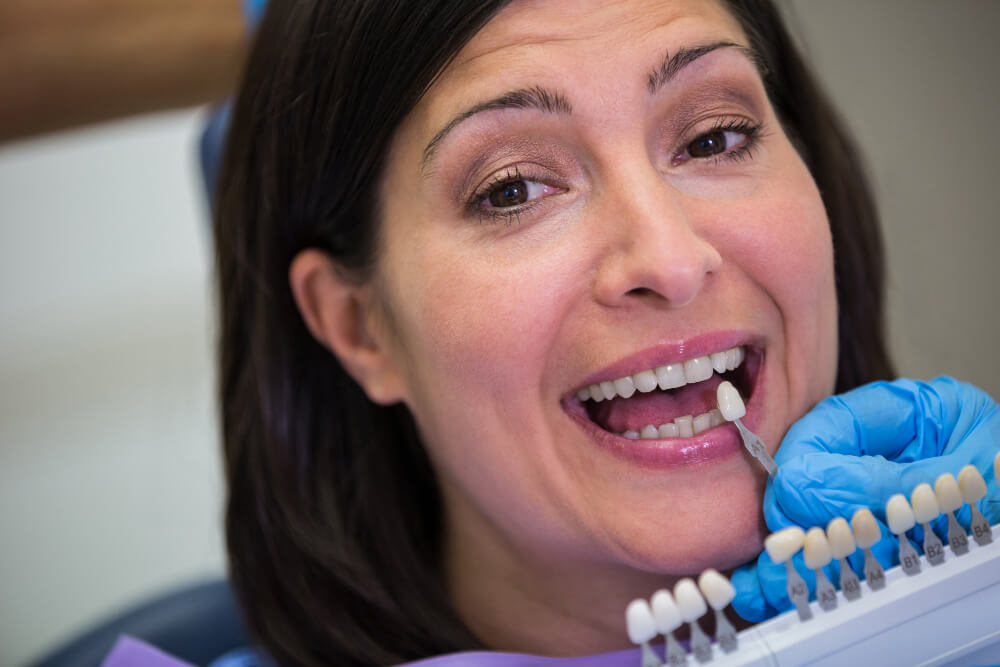Has your veneer just chipped, looks dark at the edges, or doesn’t match the rest of your smile anymore? These are common signs that your veneer may need repair or replacement. Over time, veneers can fail from daily use, staining, or small accidents. A chipped veneer can make you self-conscious when you smile, while discoloration may create unevenness compared to your surrounding teeth.
There are plenty of cases online in which people regret not being told that veneers are a long-term commitment; some also worry about irreversible enamel removal. These concerns are real, and the good news is that veneers can be removed and replaced. According to Dr. Javadi, removal must always be followed by replacement because enamel is permanently altered when veneers are first placed. After the veneer is carefully taken off, the underlying tooth will not look or function naturally. Leaving it unprotected could cause sensitivity, damage, or decay.
Dr. Javadi recommends a complete evaluation before proceeding with replacement, checking the health of your natural tooth, gums, and the quality of your previous bonding work. Once removal is complete, new veneers are designed to restore function and aesthetics. To better understand why veneers may need to be replaced, it helps to first look at why they fail over time.
Why Do Veneers Fail?
Even though porcelain is strong, veneers are thin shells attached to the front of teeth with dental glue (resin cement). Over time, several everyday factors can stress that bond.
- Normal Wear and Tear: Chewing, temperature changes, and years of brushing slowly weaken the edges of the veneer. The ADA notes that veneers may chip, crack, wear down, or loosen, sometimes requiring re-bonding or replacement.
- Bite Forces and Grinding: If you clench or grind your teeth (bruxism), especially at night, you are putting extra pressure on the thin porcelain. Without a protective night guard, this pressure can create micro-cracks or sudden chips. The ADA warns that heavy grinders or those with deep overbites may not be good candidates for veneers without added protection.
- Habits and Foods: Using your teeth to open packages, biting on pens, or chewing ice can pit porcelain against hard surfaces, leading to chips.
- Aging Adhesives: Resin cement can degrade over many years, leading to dark lines at the edges or rough spots, signaling that the bond or surrounding enamel needs attention.
- Tooth Decay at the Edge: If plaque collects where the veneer meets your tooth, decay can creep underneath and weaken the bond.
- Gum Recession or Gum Disease: As gums recede, the veneer’s edge may become exposed and easier to chip; inflammation also undermines the tooth’s support. As a periodontist, Dr. Javadi focuses on treating gum issues to ensure cosmetic work remains stable.
It’s also worth remembering that veneers aren’t meant to whiten over time. Porcelain doesn’t bleach like natural enamel, so if your natural teeth change color but your veneers don’t, the contrast can make the veneers look off. If color matching becomes an issue, replacement may be the best solution, as whitening only affects natural teeth, not porcelain or composite restorations.
Removing and Replacing Veneers
Veneers can be removed and replaced in a routine dental procedure, but the process depends on the type of veneer:
- Traditional Veneers: A small amount of enamel is removed during initial placement, so the underlying tooth requires a new veneer or crown for protection after removal, as enamel doesn’t regrow.
- No-Prep/Minimal-Prep Veneers: In select cases, these may be reversible if little or no enamel was removed, but an exam is needed to confirm.
Removal Process: Dr. Javadi usually uses a precise dental drill to carefully section and lift off the porcelain. Some dentists use special dental lasers to soften the bonding resin, which makes it easier to lift the veneer. A thorough check of the tooth, gums, and previous bonding ensures that the new veneer both restores function and looks good.
Reasons for Replacement:
- Visible chips, cracks, or rough edges you can feel with your tongue.
- Loose or leaking veneers (e.g., dark lines at the edge, food catching).
- Decay around the veneer’s margin.
- Color mismatch after years of whitening natural teeth.
- Gum recession exposing the veneer edge.
How to Protect Your Veneers
To maintain your veneers and prevent failure, it’s essential to protect both the porcelain and the underlying tooth and gums. Dr. Javadi recommends these precautions:
- See a Licensed Dentist for Veneer Work: Avoid unlicensed veneer techs to ensure quality and safety.
- Treat Gum Problems First: If your gums bleed or are receding, address these issues before replacing a veneer. A healthy gumline shields veneer edges from stress and bacteria.
- Wear a Night Guard if You Grind: If you clench or grind, ask about a custom night guard. Heavy grinders put veneers at higher risk.
- Don’t Use Teeth as Tools: Avoid tearing open packages, chewing ice, or biting pens.
- Mind Hard or Sticky Foods: Cut apples into slices and go easy on hard nuts that can damage veneer edges.
- Brush and Floss Gently but Daily: Use a soft brush and floss to keep plaque off the margins, reducing the chance of decay under a veneer.
- Know That Whitening Won’t Change Veneer Color: Porcelain and composite don’t bleach. If your natural teeth brighten but the veneer doesn’t, talk to your dentist about timing whitening before replacement for a uniform smile.
- Schedule Regular Checkups: Small issues, like a rough edge or early leakage, are cheaper to fix early than after a chip.
- Plan for Future Upkeep: Veneers are a long-term commitment. Reliable medical sources estimate porcelain veneer lifespan at 10–15 years, so budget for eventual replacement.
Are You Thinking About Removal or Replacement?
If you’re dealing with a broken, stained, or loose veneer, or you’re unsure whether a veneer is the problem, consult Dr. Ellie Javadi at Orchid Periodontics & Dental Implants. She can evaluate your gums and supporting bone and recommend treatment to ensure your next veneers last. To schedule an appointment, call (425) 775-2002.




